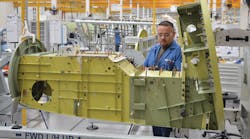Quality metrics at Cessna Mexico are eye-openingly good. First-pass yield for all finished products at this manufacturing complex is north of 99%, for example. It's a percentage that can't help but make a third-party observer question, semi-jokingly, whether the calculation was done correctly.
It was. Quality manager Jesus Acosta is happy to perform the math behind the calculation. Even more, he's proud of the processes behind this 2014 IndustryWeek Best Plants winner's ability to drive its quality numbers skyward.
To describe Cessna Mexico's attention to quality as multipronged would be an understatement. A better word is "holistic," with a variety of systems and approaches working together to achieve and sustain quality excellence. Another good word is "visual." Cessna Mexico's walls are lined with visual boards that outline the projects, the KPIs, the resources and other details that keep improvement both top of mind and easy to access.
Ultimately quality begins with the Cessna Operating System (c-OS), which is exactly what it sounds like, the primary framework that guides how the manufacturer manages its resources, methodologies and tools to build a sustainable business. Underneath the c-OS umbrella, 11 systems work in conjunction to assure Cessna addresses quality from all angles. Those systems include:
Built-in Quality (BIQ) – The easiest road to good quality is to avoid defects from the start. Where possible, Cessna has developed engineering and other error-proofing devices, but many manufacturing processes require a high level of human intervention. BIQ aims to make defect avoidance a conscious component of production line workmanship. The philosophy of BIQ is "I do not receive defects. I do not make defects. I do not pass defects." Among components of the BIQ system is a weekly meeting with associates, hosted by a quality engineer, to review higher-level quality issues and share best practices in avoidance. The system is bolstered by visual management tools that both show the defects and provide best practices in prevention.
Fast Response to Quality Concern (FRQC) – This system is externally focused and it assures that the voice of the customer is heard when a customer concern arises. Problem-solving and analysis are immediate, with preliminary analysis delivered to the customer within 24 hours. Much like with BIQ, the problem-solving activities related to customer concerns are visually displayed on large boards, and quality personnel meet daily to review those activities.
Fast Response to Quality Management (FRQM) – Like FRQC, a quick response is the aim of the FRQM system, but its customer is the quality department. Among the components of FRQM are visual control plans for special processes that give users the critical characteristics of the manufacturing processes in an easy-to-comprehend way. Layered audits and a lessons-learned tracking system also help achieve the quick-response objective.
A common component to Cessna's multiple systems is the time and attention given to analysis. Acosta explains why: "What's important to remember behind the tools is the thinking of the organization."





